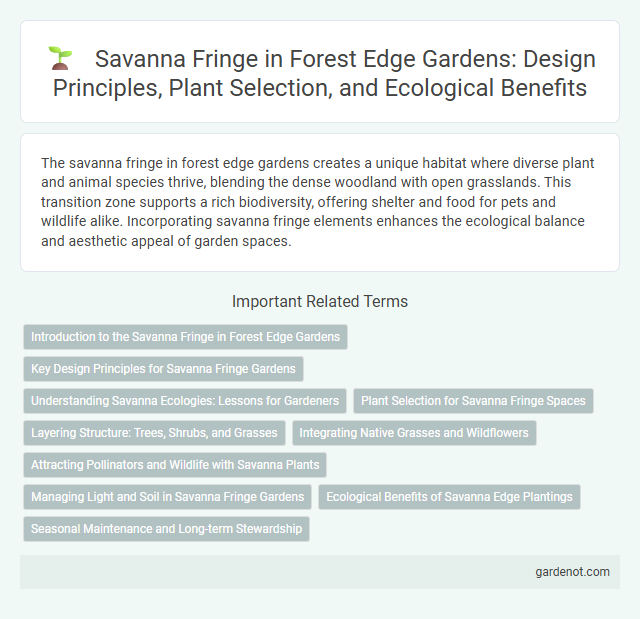The savanna fringe in forest edge gardens creates a unique habitat where diverse plant and animal species thrive, blending the dense woodland with open grasslands. This transition zone supports a rich biodiversity, offering shelter and food for pets and wildlife alike. Incorporating savanna fringe elements enhances the ecological balance and aesthetic appeal of garden spaces.
Introduction to the Savanna Fringe in Forest Edge Gardens
The savanna fringe in forest edge gardens represents a dynamic transition zone where dense forest meets open grassland, supporting a unique biodiversity of both woodland and savanna species. This ecotone fosters a rich variety of flora, including drought-tolerant grasses, hardy shrubs, and scattered trees adapted to fluctuating light and moisture conditions. Managing the savanna fringe enhances habitat connectivity, promoting wildlife movement and ecological resilience within forest edge ecosystems.
Key Design Principles for Savanna Fringe Gardens
Savanna fringe gardens emphasize the harmonious integration of native grasses and acacia trees, creating a natural transition between woodland and open plains. Key design principles include selecting drought-resistant species that mimic the layered structure of savanna ecosystems, promoting biodiversity and resilience. Incorporating irregular planting patterns and open spaces supports wildlife movement and enhances the garden's ecological function.
Understanding Savanna Ecologies: Lessons for Gardeners
Savanna fringes, where woodlands transition into grasslands, offer valuable insights into creating dynamic forest edge gardens by emphasizing biodiversity and natural layering. These ecotones support a mix of hardy grasses, shrubs, and scattered trees adapted to periodic disturbances like fire and drought, which can inspire resilient planting schemes in home gardens. Gardeners can enhance soil health and promote wildlife by mimicking savanna fringe interactions through diverse plant structures and seasonal management practices.
Plant Selection for Savanna Fringe Spaces
Selecting plants for savanna fringe spaces involves prioritizing species adapted to seasonal drought and nutrient-poor soils, such as native grasses like Andropogon gerardii and wildflowers like Echinacea purpurea. Incorporating drought-tolerant shrubs like Rhus aromatica and nitrogen-fixing legumes supports soil health and biodiversity. Emphasizing native flora ensures resilience, sustains local wildlife habitats, and enhances the ecological function of forest edge gardens.
Layering Structure: Trees, Shrubs, and Grasses
The savanna fringe in a forest edge garden features a distinct layering structure with towering trees forming the canopy, mid-level shrubs providing dense foliage, and a diverse ground layer of grasses that enhance biodiversity. Trees such as Acacia and Eucalyptus create a shaded environment supporting shrub species like Grewia and Combretum, which in turn shelter grasses like Themeda and Hyparrhenia. This stratified vegetation supports habitat complexity while promoting soil stability and nutrient cycling essential for ecosystem resilience.
Integrating Native Grasses and Wildflowers
Savanna fringe ecosystems thrive through the integration of native grasses like little bluestem and wildflowers such as purple coneflower, promoting biodiversity and soil health. Incorporating these species into forest edge gardens supports pollinator populations and enhances natural habitat connectivity. Optimizing plant selection to mirror native savanna fringes ensures sustainable growth and resilience against invasive species.
Attracting Pollinators and Wildlife with Savanna Plants
Savanna fringe gardens thrive by incorporating native savanna plants that attract a diverse range of pollinators such as bees, butterflies, and hummingbirds. These plants provide essential nectar, pollen, and habitat, supporting local wildlife and promoting ecosystem health. Including species like purple coneflower, prairie clover, and blazing star enhances biodiversity while ensuring a dynamic, sustainable garden edge.
Managing Light and Soil in Savanna Fringe Gardens
Savanna fringe gardens demand careful management of light exposure and soil conditions to mimic their natural ecosystem. Utilizing well-drained, sandy soils enriched with organic matter supports native grasses and wildflowers adapted to fluctuating moisture levels. Strategic pruning and selective shade planting optimize sunlight penetration, promoting healthy plant growth and biodiversity at the forest edge.
Ecological Benefits of Savanna Edge Plantings
Savanna fringe plantings enhance biodiversity by providing critical habitats for pollinators, birds, and small mammals, supporting ecosystem resilience. These edge plantings improve soil health through root stabilization and nutrient cycling, reducing erosion and promoting water infiltration. Integrating native grasses, shrubs, and wildflowers in savanna edges strengthens carbon sequestration and mitigates the effects of climate change in forest edge gardens.
Seasonal Maintenance and Long-term Stewardship
Seasonal maintenance of the savanna fringe involves regular invasive species removal, prescribed burns, and native plant reseeding to support biodiversity and soil health. Long-term stewardship requires monitoring ecosystem changes, promoting native flora resilience, and implementing adaptive management practices to sustain habitat quality. Consistent efforts enhance the savanna edge's ecological balance and provide critical wildlife corridors.
Savanna fringe Infographic

 gardenot.com
gardenot.com